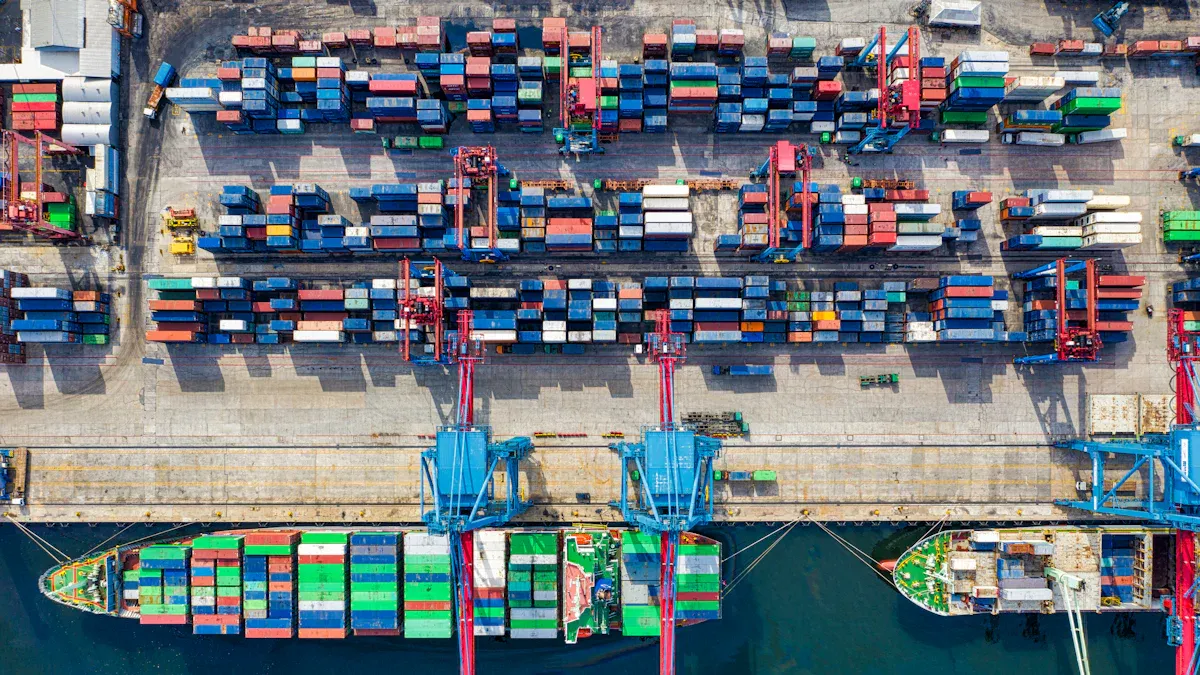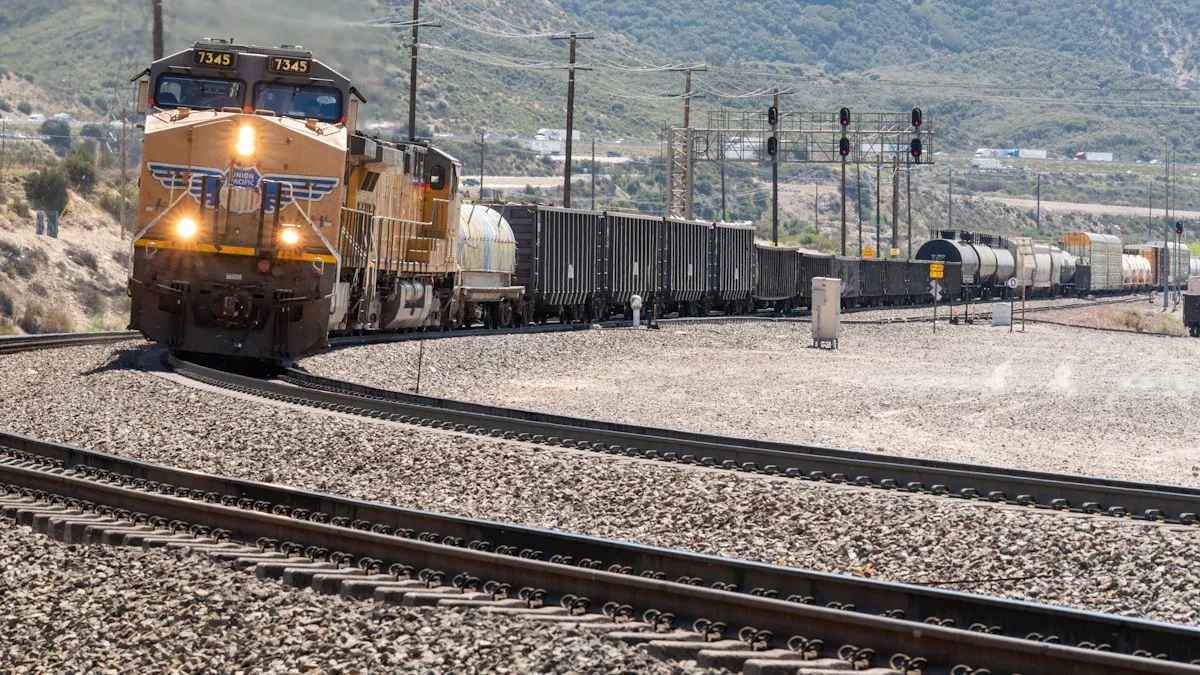Tracing the Origins of National Logistics Day and Its Role in Global Commerce

National Logistics Day first took place on June 28, 2019, thanks to Logistics Plus. Every day, logistics supports the world in remarkable ways. The global logistics market reached about $9.98 trillion in 2024 and could grow to $23.14 trillion by 2034. People rely on logistics for healthcare, manufacturing, and e-commerce. Trucking alone brought in nearly $800 billion in the U.S. in 2018. Businesses and consumers depend on fast deliveries, making celebrating global commerce logistics more important than ever. The roots of logistics stretch back through history, shaping how goods move today.
Key Takeaways
National Logistics Day, celebrated on June 28, honors the vital role of logistics in the economy and daily life.
Logistics is essential for fast deliveries in healthcare, manufacturing, and e-commerce, impacting how goods move globally.
Technology, like AI and IoT, is transforming logistics, making it more efficient and reliable for businesses and consumers.
Celebrating logistics helps raise awareness of its importance in connecting communities and supporting economic growth.
Participating in National Logistics Day events can inspire students to explore careers in logistics and supply chain management.
Day Origins
Founding Date
National Logistics Day first appeared on June 28, 2019. Logistics Plus, a global logistics company, started this special day. The founders chose June 28 to highlight the vital role of logistics in both national and global economies. This date now reminds people to appreciate logistics professionals. During recent global challenges, such as the COVID-19 pandemic, the world saw how important logistics is for delivering essential goods on time.
Purpose
The main goal of National Logistics Day is to recognize the logistics industry and its impact on daily life. The founders wanted to shine a light on the people and systems that keep goods moving. Over time, the purpose of the day has grown. At first, people linked logistics mostly with the military. Today, the meaning has changed. Logistics now covers everything from moving products to managing storage and transportation. National Logistics Day honors the workers who help businesses and communities stay connected. It also celebrates the role of logistics in economic progress and in celebrating global commerce logistics.
Did you know?
Logistics is now seen as a key part of business operations, not just a military term. The day celebrates the unsung heroes who keep the economy running smoothly.
Here are some of the specific goals the founders aimed to achieve:
Honor the efforts of logistics professionals.
Acknowledge the importance of logistics in connecting people, businesses, and communities.
Celebrate the work of logistics professionals.
Emphasize the role of logistics in economic progress.
Recognize the network of people and processes in logistics.
Honor the relationships that help move goods.
Logistics Plus Role
Logistics Plus played a leading role in creating National Logistics Day. The company wanted to bring attention to the logistics industry and its workers. They believed that logistics deserved more recognition for its contributions to the economy and job creation. The table below shows the key reasons Logistics Plus gave for starting the day:
Key Reasons for Establishing National Logistics Day | Description |
|---|---|
Recognition of the Logistics Industry | To acknowledge the importance of logistics in national and global economies. |
Contribution to Employment | To highlight logistics' role in job creation. |
Economic Impact | To emphasize logistics' significance in the overall market. |
Early celebrations included events, social media campaigns, and messages of thanks to logistics workers. Many people welcomed the new holiday. Companies and organizations joined in, sharing stories and showing support for logistics professionals. The day quickly became a way to bring more attention to the industry and to encourage more people to learn about the value of logistics.
Logistics Evolution

Early History
People have moved goods for thousands of years. Ancient civilizations built the first systems to manage supplies and trade. The table below shows how early societies used logistics:
Civilization | Logistics Practice Description | Time Period |
|---|---|---|
Ancient Greece | Military logistics involved planning and provisioning for armies, ensuring supply delivery. | 5th century BC |
Roman Empire | Developed sophisticated logistics systems, including road networks and supply depots. | 1st century BC |
Early Trade Routes | Logistics became essential for managing goods movement across long distances for trade. | 1st millennium BC |
The Silk Road stands out as a major step in logistics history. This network of trade routes connected the Mediterranean with the East. Merchants and explorers, such as Marco Polo, traveled these routes. They helped spread goods, ideas, and new ways to manage trade. Marco Polo described China's canal-based transport and the Mongol Empire's fast communication system. These examples show how logistics shaped early global trade.
Key Milestones
The Industrial Revolution changed logistics forever. Steam engines powered new railways and ships. Goods moved faster and farther than ever before. In the 19th century, railroads made freight shipping quicker. The 20th century brought gasoline vehicles and the Interstate Highway System, which improved road transport. Airplanes and the internal combustion engine opened new paths for goods. By the 1950s, containerization standardized cargo handling. This made loading and unloading faster and safer. These changes helped create the modern systems used for celebrating global commerce logistics.
Modern Advances
Today, technology drives logistics forward. Big data analytics helps companies understand customer needs and improve supply chains. The Internet of Things (IoT) allows real-time tracking of goods. Cloud computing makes sharing information easier. Automation speeds up warehouse work and reduces mistakes. Companies use AI to cut costs and make better decisions. Digitized companies now fulfill 67% of customer requests, compared to only 30% for non-digitized ones. Autonomous trucks and drones are changing how deliveries happen. These advances make logistics more efficient and reliable for everyone.
Celebrating Global Commerce Logistics
Industry Recognition
National Logistics Day brings attention to the achievements of the logistics sector. Industry organizations use this day to celebrate the transportation and logistics industry. They express pride in the hard work and dedication of logistics companies. The U.S. logistics industry is valued at $343 billion, while the global market stands at $1.3 trillion and is expected to reach $2.8 trillion by 2031. Many companies highlight their teams' achievements and share success stories. They also promote collaboration among different stakeholders. These efforts help people understand the importance of celebrating global commerce logistics.
Industry groups show appreciation for logistics professionals.
Organizations promote awareness of the logistics industry's significance.
Companies encourage teamwork and knowledge exchange.
Public Awareness
Public perception of logistics has changed since the introduction of National Logistics Day. People now recognize the sector for optimizing supply chains and reducing costs with advanced technologies. The public sees logistics as a key player in global trade and compliance with regulations. During crises, such as pandemics, the logistics industry has shown its ability to support communities and maintain stability. There is also growing acknowledgment of logistics professionals' efforts toward sustainability and environmental responsibility. These changes help more people see the value in celebrating global commerce logistics.
The public understands logistics' role in supply chain efficiency.
People appreciate logistics' impact on international trade.
Communities recognize the industry's crisis management skills.
There is more awareness of sustainable practices in logistics.
Events and Initiatives
On National Logistics Day, companies and professionals organize events to honor the sector. Many host educational workshops and webinars to teach others about logistics. Social media campaigns share stories of logistics workers and their contributions. Some organizations launch initiatives to foster innovation and knowledge exchange. These activities help educate the public and inspire future leaders in logistics. By celebrating global commerce logistics, the industry continues to grow and adapt to new challenges.
Tip: Participating in National Logistics Day events can help students learn about career opportunities in logistics and supply chain management.
Global Commerce Impact

Economic Role
Logistics plays a huge part in the world economy. The sector makes up about 10-15% of global GDP. This number changes from country to country. Some countries have more efficient logistics systems than others. When logistics works well, businesses save money and people get products faster. Efficient logistics helps countries trade with each other. It also creates jobs and supports many industries.
The logistics sector accounts for an average of 10-15% of global GDP.
This percentage varies by country, indicating differences in logistics efficiency.
During major events like the COVID-19 pandemic, the world saw how important logistics is for keeping economies stable. The pandemic caused big problems for supply chains. Companies had to act fast to keep goods moving. Many businesses invested in new technology and found new ways to deliver products. These changes helped them adapt and continue serving customers.
Note: The COVID-19 pandemic forced logistics companies to balance employee safety with operational demands. Companies that diversified sourcing and shipping routes managed disruptions better. Investment in digital platforms and real-time tracking became essential for effective logistics during the crisis.
Technology
Technology shapes the future of logistics. Companies use new tools to make their work faster and more accurate. Artificial intelligence (AI) helps businesses predict what products people will need. AI also helps manage warehouses and automate tasks. Blockchain technology keeps records safe and easy to check. The Internet of Things (IoT) lets companies track shipments in real time. Many companies now focus on eco-friendly practices, such as using electric trucks and carbon-neutral shipping.
Artificial Intelligence (AI): Improves demand forecasting and automates warehouse operations.
Blockchain Technology: Makes supply chains more transparent and secure.
Internet of Things (IoT): Tracks and monitors shipments in real time.
Sustainability Initiatives: Support greener operations with electric vehicles and eco-friendly shipping.
AI also helps companies manage inventory. It can decide when to order more products and how much to buy. This reduces waste and saves money. AI-driven systems can create purchase orders automatically. They use real-time data to make smart choices. Some companies use just-in-time inventory management. This means they only keep what they need, which lowers storage costs.
AI improves inventory levels and reduces the need for extra stock.
Accurate demand forecasting helps avoid running out of products or having too much.
Automated reordering saves time and makes buying supplies easier.
A German manufacturer worked with a global AI company to improve their data strategy. This partnership saved them about $30 million. This example shows how technology can make logistics more efficient and cost-effective.
Real-World Examples
Many companies lead the way in celebrating global commerce logistics by using smart strategies and new technology. The table below shows how some of the biggest names in business use logistics to improve their operations:
Company | Strategy Description | Key Implementations | Results |
|---|---|---|---|
Alibaba | Uses big data and AI to boost logistics in e-commerce. | Predictive analytics, real-time tracking, optimized network | Faster deliveries, cost savings, higher efficiency |
DHL | Focuses on sustainability to lower environmental impact. | Electric vehicles, energy-efficient warehouses, green packaging | Lower carbon footprint, cost savings, better image |
Walmart | Builds efficient supply chains for low prices and stock. | Centralized distribution, vendor partnerships, advanced tech | Cost reduction, better inventory, happy customers |
Procter & Gamble | Uses advanced inventory management for best stock levels. | Demand forecasting, integrated systems, ongoing improvement | Cost savings, optimal inventory, smooth operations |
These companies show how logistics can help businesses grow and serve customers better. They use technology, smart planning, and green practices to stay ahead. Their success stories inspire others to keep improving and adapting.
Tip: Learning about these real-world examples can help students understand how logistics shapes the world and why it matters for everyone.
Logistics continues to shape global commerce with new ideas and technology. National Logistics Day inspires people to value this industry and look for better ways to move goods. The future of logistics will see:
More sales channels and stronger supply chains
Easier access to shipping carriers
Greener and more automated operations
Smarter last-mile delivery solutions
National Logistics Day encourages the industry to:
Work together across the supply chain
Focus on sustainability and customer needs
Logistics will keep growing and changing the world.
FAQ
What is National Logistics Day?
National Logistics Day takes place on June 28 each year. People use this day to honor the logistics industry and its workers. The day highlights how logistics connects businesses, communities, and people around the world.
Who started National Logistics Day?
Logistics Plus, a global logistics company, started National Logistics Day in 2019. The company wanted to recognize the important role logistics plays in the economy and daily life.
Why does logistics matter in global commerce?
Logistics helps move goods quickly and safely. Companies rely on logistics to deliver products to customers. Efficient logistics supports trade, creates jobs, and helps economies grow.
How do companies celebrate National Logistics Day?
Companies host events and workshops.
Many share stories about logistics workers.
Some launch new projects or support local communities.
Tip: Students can learn about logistics careers by joining these events.
See Also
Key Strategies for Effective Global Logistics Operations
Enhancing International Operations Through Innovative Logistics Solutions
Streamlined Supply Chain Optimization Using American Logistics Solutions
Boosting Global Efficiency with Point-to-Point Logistics Systems
PGL’s Expertise Ensures Smooth Flow of American Supply Chains
